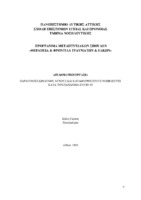| dc.contributor.advisor | Πολυκανδριώτη, Μαρία | |
| dc.contributor.author | Ελένη, Γεράνη | |
| dc.date.accessioned | 2024-03-15T11:36:47Z | |
| dc.date.available | 2024-03-15T11:36:47Z | |
| dc.date.issued | 2024-02-16 | |
| dc.identifier.uri | https://polynoe.lib.uniwa.gr/xmlui/handle/11400/6096 | |
| dc.identifier.uri | http://dx.doi.org/10.26265/polynoe-5932 | |
| dc.description | Συστηματική ανασκόπηση | el |
| dc.description.abstract | Εισαγωγή: H πανδημία COVID-19 έχει προκαλέσει παγκόσμια κρίση στον τομέα της
δημόσιας και της ψυχικής υγείας και της οικονομίας. Οι νοσηλευτές αποτελούν την μεγαλύτερη
ομάδα των εργαζομένων στον τομέα της υγειονομικής περίθαλψης πρώτης γραμμής και
διαδραματίζουν καίριο ρόλο στην αντιμετώπιση της πανδημίας. Οι αυξημένες απαιτήσεις για
την αντιμετώπιση έκτακτων αναγκών στον τομέα της δημόσιας υγείας επηρεάζουν εκτός από
τη σωματική και την ψυχική υγεία των νοσηλευτών.
Σκοπός: Σκοπός της παρούσας συστηματικής ανασκόπησης ήταν η διερεύνηση των
παραγόντων κινδύνου άγχους και κατάθλιψης στους νοσηλευτές κατά τη διάρκεια της
πανδημίας COVID-19.
Μεθοδολογία: Πραγματοποιήθηκε συστηματική ανασκόπηση της τρέχουσας, διεθνούς
βιβλιογραφίας στις ηλεκτρονικές βάσεις αποδελτίωσης βιβλιογραφικών δεδομένων: PubMed,
Google Scholar, Cochrane, Science Direct, BMJ, Pro-Quest. Αναζητήθηκαν συγχρονικές
μελέτες από την έναρξη της πανδημίας έως τον Μάρτιο του 2022. Κριτήρια ένταξης ήταν
μελέτες δημοσιευμένες στην αγγλική που αξιολόγησαν το άγχος και την κατάθλιψη κατά τη
διάρκεια της πανδημίας COVID-19 και τους σημαντικούς παράγοντες κινδύνου ψυχικών
διαταραχών με πληθυσμό νοσηλευτές που φρόντισαν ύποπτους και επιβεβαιωμένους ενήλικες
ασθενείς με COVID-19. Οι λέξεις-κλειδιά των μελετών σχετίστηκαν με το εννοιολογικό
περιεχόμενο του τίτλου της παρούσας εργασίας.
Αποτελέσματα: 15 μελέτες πληρούσαν τα κριτήρια ένταξης στη συστηματική ανασκόπηση.
Το συνολικό δείγμα των μελετών αποτέλεσαν 30.469 νοσηλευτές. Τα αποτελέσματα των
μελετών έδειξαν ότι οι νοσηλευτές κατά τη διάρκεια του πρώτου κύματος της πανδημίας
ανέφεραν ότι εμφάνισαν συμπτώματα άγχους και κατάθλιψης σε ποσοστό που κυμάνθηκε από
29,8% έως 78% και από 18,4% έως 84,3% αντίστοιχα. Ο φόβος μόλυνσης στο εργασιακό
περιβάλλον και ο φόβος μετάδοσης του ιού στα μέλη της οικογένειας αποτελούσε σημαντικό
παράγοντα κινδύνου εμφάνισης συμπτωμάτων άγχους. Ορισμένα δημογραφικά
χαρακτηριστικά φάνηκε ότι αποτελούσαν παράγοντα κινδύνου άγχους και κατάθλιψης. Το
χαμηλότερο επίπεδο εκπαίδευσης σχετίστηκε με τον κίνδυνο εμφάνισης καταθλιπτικών
συμπτωμάτων. Χαρακτηριστικά της προσωπικότητας, ο τρόπος αντιμετώπισης και η
ανθεκτικότητα συνδέθηκαν με την εμφάνιση συμπτωμάτων άγχους και κατάθλιψης.
Συμπεράσματα: Επισημαίνεται ο κίνδυνος αγχώδους και καταθλιπτικής διαταραχής στους
νοσηλευτές. Η ολοκληρωμένη οργανωτική προσέγγιση και η εξασφάλιση πόρων από τους
οργανισμούς υγειονομικής περίθαλψης κρίνεται σημαντική.
Λέξεις-κλειδιά: Παράγοντες κινδύνου, άγχος, κατάθλιψη, νοσηλευτές, νόσος κορονοϊού
πανδημία | el |
| dc.format.extent | 82 | el |
| dc.language.iso | el | el |
| dc.publisher | Πανεπιστήμιο Δυτικής Αττικής | el |
| dc.rights | Αναφορά Δημιουργού - Μη Εμπορική Χρήση - Παρόμοια Διανομή 4.0 Διεθνές | * |
| dc.rights | Attribution-NonCommercial-NoDerivatives 4.0 Διεθνές | * |
| dc.rights.uri | http://creativecommons.org/licenses/by-nc-nd/4.0/ | * |
| dc.subject | Risk factors | el |
| dc.subject | Anxiety | el |
| dc.subject | Depression | el |
| dc.subject | Nurses | el |
| dc.subject | COVID-19 | el |
| dc.subject | Pandemic | el |
| dc.title | Παράγοντες κινδύνου άγχους και κατάθλιψης στους νοσηλευτές κατά την πανδημία COVID-19 | el |
| dc.title.alternative | Risk factors of anxiety and depression in nurses during the pandemic COVID-19 | el |
| dc.type | Μεταπτυχιακή διπλωματική εργασία | el |
| dc.contributor.committee | Κελέση, Mάρθα | |
| dc.contributor.committee | KOUTELEKOS, IOANNIS | |
| dc.contributor.faculty | Σχολή Επιστημών Υγείας & Πρόνοιας | el |
| dc.contributor.department | Τμήμα Νοσηλευτικής | el |
| dc.contributor.master | Θεραπεία και Φροντίδα Τραυμάτων και Ελκών | el |
| dc.description.abstracttranslated | Introduction: The COVID-19 pandemic has caused a global crisis in public health, mental
health, and economy. Nurses are the largest group of frontline healthcare workers, and they
have a critical role in the response to the pandemic. The increased demands for emergency
treatment in the field of public health affects not only to the physical but mental health of nurses.
Aim: The aim of this systematic review was to explore the risk factors for anxiety and
depression in nurses during the COVID-19 pandemic.
Methodology: A systematic review of the current, international literature was performed in the
electronic databases: PubMed, Google Scholar, Cochrane, Science Direct, BMJ, Pro-Quest. We
searched for cross-sectional studies from the start of the pandemic to March 2022. Inclusion
criteria were studies published in English that assessed anxiety and depression during the
COVID-19 pandemic and important risk factors for mental disorders with a population of
nurses who cared for suspected and confirmed adult patients with COVID-19. The keywords
of the studies were related to the conceptual content of the title of this study.
Results: 15 studies met the inclusion criteria for the systematic review. The total sample of the
studies consisted of 30.469 nurses. The results of the studies showed that nurses during the first
wave of the pandemic reported experiencing symptoms of anxiety and depression in a
percentage that ranged from 29.8% to 78% and from 18.4% to 84.3%. The fear of contamination
in the work environment and the fear of transmitting the virus to family members was a
significant risk factor for anxiety symptoms. Certain demographic characteristics appeared to
be a risk factor for anxiety and depression. Lower level of education was associated with the
risk developing depressive symptoms. Personality traits, coping style and resilience were
associated with the occurrence of anxiety and depression symptoms.
Conclusions: The risk of anxiety and depressive disorder in nurses is highlighted. An integrated
organizational approach and securing resources from health care organizations is considered
important in mitigating vulnerability.
Keywords: Risk factors, anxiety, depression, nurses, COVID-19 (coronavirus disease), pandemic | el |


